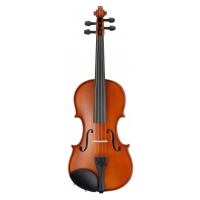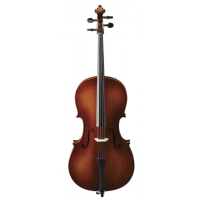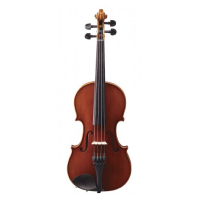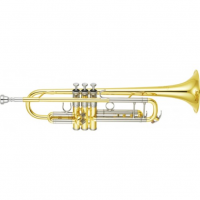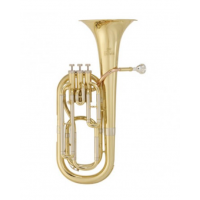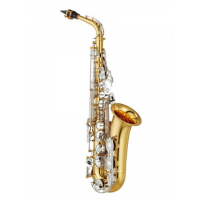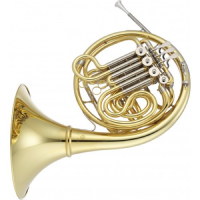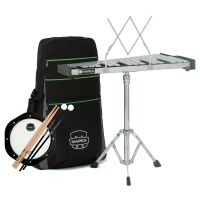Anatomy of the Clarinet
The clarinet is a woodwind instrument with a single reed and long cylindrical body.
There are many types of clarinets, including the Bb and A soprano clarinets (the most common types seen today), the alto clarinet, the bass clarinet, the Eb clarinet, the octo-contrabass clarinet (a rarity) and the Ab piccolo clarinet. The clarinet is capable of impressive range in the right player's hands.
Clarinets come apart into five pieces: mouthpiece, barrel, upper joint, lower joint and bell. These pieces must be fitted together in precise alignment for proper playing to be possible.
Up and down the surface of the body are holes through which air can escape when left uncovered. Using levers and keys mounted on steel rods, the player covers and uncovers different sets of holes to produce all the tones of the scale while blowing air through the clarinet.
A clarinet body is usually made of grenadilla wood or plastic, though other materials are used as well in specialty instruments such as hard rubber ("vulcanized"), metal, plastic and more.
To be the best you can be at playing the clarinet, you should know all of the usual names of the parts of the clarinet and what function they perform. You should also know how individual clarinet parts can be removed and replaced, how clarinet parts should be serviced and maintained and what to do if you think a part of your student clarinet is damaged or broken.
Let's learn about the anatomy of a typical clarinet from end to end. If you'd like to jump ahead, use the anatomy chart above to click a part you'd like to read about first.
WHAT IS THE BARREL?
The clarinet barrel connects the instrument's mouthpiece and body, shaping and directing sound through the instrument.
The inside shape of the barrel is known as the taper, which can be straight, standard, reverse or double. A straight taper has the same size on both ends, while a standard taper is slightly smaller at the top of the barrel than the bottom. Reverse taper barrels are the opposite of the standard, with a bottom opening slightly smaller than the top. A double taper is rare, but means that the center of the barrel inside is smaller than on the ends.
The sound that the barrel produces is affected by the taper as well as its weight and the type of wood from which it is fashioned.
Minor tuning adjustments can be performed by pulling the barrel away from the upper joint a tiny amount. This will lower the overall pitch of the instrument, making it more flat. Unfortunately, you are limited to this direction of fine tuning only: there is physically no way to adjust the clarinet to make the tone more sharp than it is when all the sections are connected snug against each other.
When you finish each playing session, be sure the instrument is dry inside and out before storing. Pay particular attention to the tenons, which can swell with moisture or even general humidity and make the joints difficult to separate. A thorough swabbing is the first step, followed by another round of drying with a soft, absorbent instrument cloth.
Click to return to anatomy chart
WHAT ARE THE BARREL RINGS?
Barrel rings constrict the ends of the barrel so the pressure of the tenon corks inside won't split the barrel.
Barrel rings are seen on the barrel section of many clarinets as thin strips of metal that run around the diameter of the barrel at each end. Depending on the clarinet, they may be purely cosmetic or they might not be there at all. But actual barrel rings perform a vital function on the clarinet.
The tenon corks inside the barrel exert tremendous outward force: enough that they can actually split the barrel into two pieces if the barrel rings are loose or missing. However, certain designs of barrel are made such that no rings are needed.
If your barrel rings loosen or fall off your clarinet, it could be a sign that your environment is too dry and the barrel wood is contracting. Over the long term, don't risk damaging your clarinet by allowing this to go unfixed. Sometimes playing the instrument for a while can add enough moisture to make the barrel expand again. However, it is still best to take your clarinet to a professional to troubleshoot the problem.
Click to return to anatomy chart
WHAT IS THE BELL?
The bell is the flared section at the end of the clarinet from which the sound projects.
The bell is the last of five sections of the clarinet where the sound projects out from the instrument. It is located at the bottom end of the clarinet and comes in an almost infinite selection of lengths, flares, weights, bores and more.
Be very careful when carrying the instrument out of the case or holding it at rest to be sure the bell does not bump against something and become damaged.
Click to return to anatomy chart
WHAT IS THE BELL RING?
The bell ring constricts the top end of the bell so the force of the tenon inside doesn't split the wood.
The bell ring is a thin strip of metal that is often seen as a band on the upper end of the clarinet bell. Some bell rings are cosmetic only, while other bells have no rings at all depending on the make of the clarinet. Functionally, the bell ring compresses the end of the bell so the force of the tenon and cork inside it when the instrument is assembled won't cause the bell to crack or split.
Click to return to anatomy chart
WHAT IS THE BRIDGE KEY?
The bridge key connects the upper and lower joints' key rod network to each other.
The body of the clarinet splits into two halves called the upper and lower joints. When the two parts are brought together, the bridge key connects the key mechanism from the upper to the lower joints.
When you are assembling the instrument, be careful to handle the upper and lower joints gently and raise the bridge key so the key on the lower joint can fit underneath the bridge key.
Click to return to anatomy chart
WHAT IS THE CORK?
The clarinet's four tenons are covered in springy cork to create an airtight seal.
Since the clarinet is made in five sections, there needs to be a means of connecting the pieces securely with an airtight result. Four tenons perform this duty and cork is part of the job. Cork covers each tenon of the clarinet, creating an airtight seal when it is inserted into the adjoining section.
As you begin to put the instrument together, you might notice that the parts are especially resistant to being put together. This is likely the result of changing humidity or an instrument that was stored incorrectly. A small amount of cork grease applied to each cork should allow the instrument to be put together again without much difficulty. If grease doesn't do the job, then your next stop should be an instrument repair shop where an expert can sand down the cork a small amount.
Over time, corks will become compressed and fit more loosely in the adjoining section. This situation will eventually require you to replace the old corks with new ones. Beware of a new clarinet where the joints fit together loosely already, as its corks will inevitably continue to shrink and require a repair and/or replacement sooner than expected.
Click to return to anatomy chart
WHAT IS THE LOWER JOINT?
The lower joint is the lower half of the clarinet's body, where each note's pitch is determined.
The upper and lower joints come together in assembly to form the body of the clarinet.
By pressing different combinations of keys, the player can adjust the pitch of the note being blown. The clarinet has an approximate four octave range, though more advanced players can go even higher still.
Traditionally, the holes and keys of the lower joint are played with the right hand.
Click to return to anatomy chart
WHAT IS THE UPPER JOINT?
The upper joint is one half of the clarinet's body, where each note's pitch is determined.
The upper and lower joints come together in assembly to form the body of the clarinet. It is on these sections that the tuning holes and delicate key apparatus is located.
To play the clarinet, the player sends air through the instrument from the reed and mouthpiece down through the barrel into the two joints. By pressing different combinations of keys, the player can adjust the pitch of the note being blown. The clarinet has an approximate four octave range, though more advanced players can go even higher still.
The manufacturer's logo and instrument serial number are typically found on the upper half of the upper joint.
Traditionally, the keys and holes on the upper joint are mostly played with the left hand. The holes and keys of the lower joint are usually played with the right hand.
Click to return to anatomy chart
WHAT ARE THE KEYS?
Padded keys cover and uncover tone holes to change the pitch of the clarinet.
Clarinet keys are small, round padded metal rings, covers or levers that are mounted on metal rods. They alternatively cover and uncover the tone holes in the sides of the clarinet when combinations of fingerings are made. They change the flow of air through the clarinet and thereby raise or lower the pitch.
Levered keys are depressed with a finger and press down combinations of padded metal covers over selected tone holes. The fingers might also press down keys that are solid or hollow in the center ("ring" keys) to cover tone holes.
One of the greatest challenges the beginning player faces is how to cover all the ring keys completely with the fingers no matter what combination of keys are used. A tight air seal is necessary to produce a full, accurate pitch and a leaking finger can cause an irritating squeak to occur.
The distance between key and body can be fine tuned to suit the specific hand shape and strength of the individual player. Sometimes a player's hand simply cannot be positioned properly no matter how long he/she might practice: it is a purely physical limitation that a simple tech adjustment can fix.
Though made of metal, the clarinet's keys are surprisingly easy to bend by accident, so great care should be made to keep the keys in pristine shape. Remember, even the slightest bump sustained by the keys could render the clarinet unplayable.
Click to return to anatomy chart
WHAT IS THE LIGATURE?
The ligature is an adjustable metal band that holds the reed fast in place on the clarinet's mouthpiece.
The ligature is a small apparatus shaped like a thin band that curves around the mouthpiece and is held together with two ligature screws. It holds the reed in place on the mouthpiece and can help shape the clarinet's sound quality depending on the material from which it is made.
There are many types of materials used in ligatures today, including gold plated, nickel-plated, plastic, leather and even string. Plated metals help the clarinet project easily and powerfully for the largest stages, while the organic materials can generate a softer tone that works better in more intimate playing environments.
When the clarinet is assembled, the ligature is first slipped loosely over the mouthpiece into position and the reed is placed underneath. After lining up the tip of the clarinet mouthpiece with the end of the reed, the player tightens the ligature screws to hold the reed in place. Be careful not to tighten the ligature screws too much, as you could strip the threads of the screws (or at least have difficulty unscrewing them later) or break the reed. Firm pressure is enough. Experiment with variations in tightness and you'll discover some remarkable variations in tone.
To clean the ligature, buff it gently with a clean soft cloth.
Click to return to anatomy chart
WHAT IS THE MOUTHPIECE?
The mouthpiece holds the clarinet's reed and sends its vibrations into the instrument.
The mouthpiece is the top part of the clarinet that holds the reed and offers an opening for air to pass into the clarinet. The mouthpiece also shapes the instrument's tone through its interior shape and, to a limited extent, from the materials used in it's construction. The space between the reed and the mouthpiece tip where air passes through is called the tip opening, which will also vary the clarinet's tone depending on the width of the opening.
The flat area where the reed sits on the mouthpiece is called the table. The clarinet's ligature fastens over the table to hold the reed in place. Inside the mouthpiece is a small narrow resonating cavity where sound waves pass through from the tip opening out into the barrel and body of the clarinet to deliver sound out of the bell.
There are dozens of different makes and styles of mouthpiece for the clarinet. Most clarinet mouthpieces are made of plastic or vulcanized ("hard") rubber, though you will also see metal, glass and wood.
Be careful when you are carrying the assembled instrument or handling the parts to be sure that you don't knock the mouthpiece against something or drop the mouthpiece itself to the floor. Even the slightest chip can have an impact on your tone and the playability of the instrument.
The best way to keep your mouthpiece clean is to dry the mouthpiece every time after you play. In addition, it is a good idea to rinse it with lukewarm water and wipe it dry every one to two weeks. Cleaning your clarinet mouthpiece is also recommended before you store the instrument for a period of time. Observe good habits with keeping your mouthpiece clean and it will last for years. If you put your instrument away wet and don't open the case for a month, you could have a difficult cleaning job on your hands!
Click to return to anatomy chart
WHAT IS THE REED?
The reed is a thin strip of cane mounted on the mouthpiece that vibrates to generate the clarinet's sound.
The reed is a thin strip of cane mounted on the mouthpiece that vibrates to generate the clarinet's sound when the player applies the right combination of air pressure and embouchure. A clarinet reed is shaped like a long rectangle with one thinly tapered end flaring out slightly in a rounded shape that matches the upper edge of the clarinet's mouthpiece. This end is the playing end and the other is where the reed is held fast against the clarinet by the ligature.
Reeds are manufactured in five levels of rigidity ranging from soft to hard. Playing is easier with a soft clarinet reed but players generally graduate to harder reeds as their technique and ability progresses.
Reeds are made of organic material and come under a lot of stress as they are played. Inspect your reeds for signs of warping, cracks or splitting and discard any worn out reeds before they affect your tone.
To position the reed correctly, place it under the ligature and move it down until you can see a tiny line of black behind the top just below the tip of the mouthpiece. Then tighten the ligature screws to hold the reed firmly and test the instrument to see if they are at an ideal tension for the sound you are trying to produce. Over time, you'll learn to quickly adjust the tension to achieve a consistent tone every time you play.
When tightening the ligature, use just enough tension to hold the reed firmly. If you over-tighten the screws, they will be difficult to unscrew and may develop damage in the threads.
After every playing session, dry the reed with a soft cloth. Then it should be stored with a protective reed guard or installed back on the clarinet's mouthpiece before putting in your case. Never store reeds loose in your case: they will inevitably be lost or damaged.
Click to return to anatomy chart
WHAT IS THE REGISTER KEY?
The register key lifts the pitch of the clarinet up by an octave plus a fifth.
Located at the rear (player) side of the clarinet on the body area, the register key is a small lever that causes the instrument's pitch to jump up an octave plus a fifth when it is pressed. This interval is also known as a "twelfth." It is one of the defining features of a modern era clarinet.
The register key is played with the left thumb.
Click to return to anatomy chart
WHAT ARE THE TENONS?
Covered in springy cork, the tenons keep the five clarinet sections fitting tightly together, making an airtight connection.
The clarinet has four cork-covered tenons to hold the five pieces together in playing configuration. Each tenon protrudes from one end of a section and is shaped perfectly to fit firmly into the next section, making an airtight connection.
Having to use too much or too little force to assemble the clarinet is a sign that your corks might need replacing soon. Corks respond quickly to atmospheric change and also compress gradually over time. Eventually, replacement is the only option to maintain a proper air seal.
Be very carful when you assemble your clarinet. There is a tendency to grasp the clarinet too tightly and incorrectly by the keys and when it is a tight fit the keys can become bent or even broken when twisted with pressure.
Click to return to anatomy chart
WHAT ARE THE TONE HOLES?
Cut into the body of the clarinet, tone holes can be covered or uncovered by the player's fingers, altering the resonant properties of the enclosed air being blown and resulting in changes to the pitch of the sound (creating different "notes").
While playing, it is very important to be sure that your fingertips create a tight seal over the tone holes, or you will be more prone to squeaking as you play. This is one area where a professional adjustment might improve your playing: depending on your hands' size and shape, it might be easier if a ring key under a particular finger is set closer or farther away from the tone hole when at rest.
The correct playing position utilizes a less arched finger so there is more fleshy area of the fingertip to make a seal over the hole.









